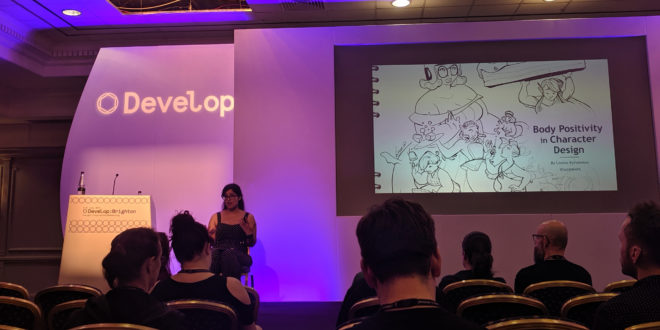Veteran freelance artist Lucy (Loukia) Kyriakidou addressed the need for more diverse bodies in games during her talk at Develop:Brighton yesterday. If you look at the main characters from the best selling games of 2018 (which she did, see below), it’s interesting to see how they’re not very different from one another and mostly show the same body types.
Currently working on Battletoads’ characters and having extensive experience in character design, Kyriakidou explained simply why change is needed: “It is the right thing to do and it is what players want,” she said. “Studies have shown that players do want more diversity in games – and that’s general diversity, not just bodies. More than 50 per cent of gamers do believe that it’s getting better but we need to do more than just try to tick a box. Games have a social responsibility. We’re responsible for a lot of screen time in people’s lives so to not hold yourself accountable for the impact games have on people’s lives is no longer an option.
“Also, accuracy is not an excuse not to have women and people of colour in your game. It’s not wrong to have muscular men and hourglass women bu we need to represent our audience better and the people who are actually playing our games. It’s great to have NPCs that are body diverse but it’s better to have the same for a protagonist.”
“To not hold yourself accountable for the impact games have on people’s lives is no longer an option.”
She shared her tips for artists who want to overcome projecting their own ideals: “The best way to get better is to review your work, see where you are now and see where you want to be in the future. I review my work every year.”
Reviewing her earlier work she realised there was a “not a lot of diversity in anything” and she needed to leave her comfort zone: “You need to push yourself because no one is going to do for you.”
Limited design skills can also be a factor as you end up “reaffirming you own ideals by creating a default for yourself” and always creating the same body shape over and over. Once again you need to push yourself to go beyond this default.
Finally there’s also a personal aspect in this, which seems to have been the trigger for Kyriakidou to start championing body diversity in her character design: “I realised I wasn’t even representing myself in my art and I found that very hurtful. I had internalised that what I looked like needed fixing or stylised in order for the imperfections to go away.”

Among her tips for artists, she advised them to challenge their own biases by making researches on body types and find resources they can work from (one of them being ‘Olympics bodies’, as photographed by Howard Schatz for his Athlete book: you can see a few of these photos on this page).
She also advised to create moodboards “to force yourself to do some research.” She highlighted that bodies don’t necessarily look the same depending on the culture as well, saying for instance that the ‘typical’ woman in Greece doesn’t look the same than the one in the UK – and neither does her body type.
Character redesign exercises are also good practice: “Fan art is amazing – if you take a character that already exists and recreate it you can really understand the impact of their story on their body type,” and it allows you to practice different shapes.
“Introduce body diversity to your personal work” as well, Kyriakidou recommended. “Draw from personal experiences and relationships and always review your work to avoid stereotypes. Weight is NOT a personality trait. No, big characters are not always funny.”
If you are interested in reading more about the impact of body representation in games, Kyriakidou recommended the following resources:
– Bartlett and Harries (2008), The Impact of Body Emphasizing Video Games on Body Image Concerns in Men and Women
– Sylvia Zeely (2013), Virtual Ideals: The Effect of Video Game Play on Male Body Image

 MCV/DEVELOP News, events, research and jobs from the games industry
MCV/DEVELOP News, events, research and jobs from the games industry




